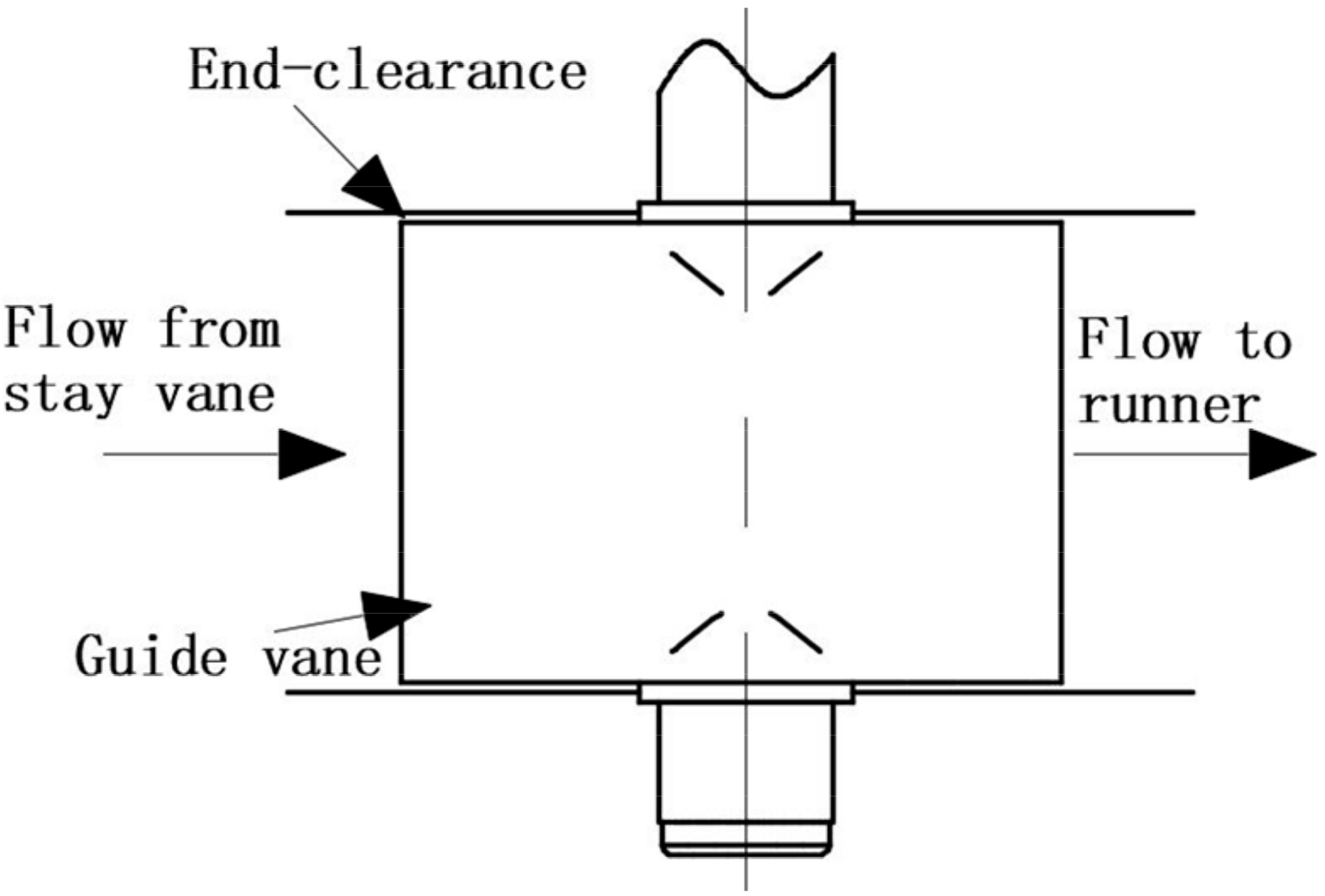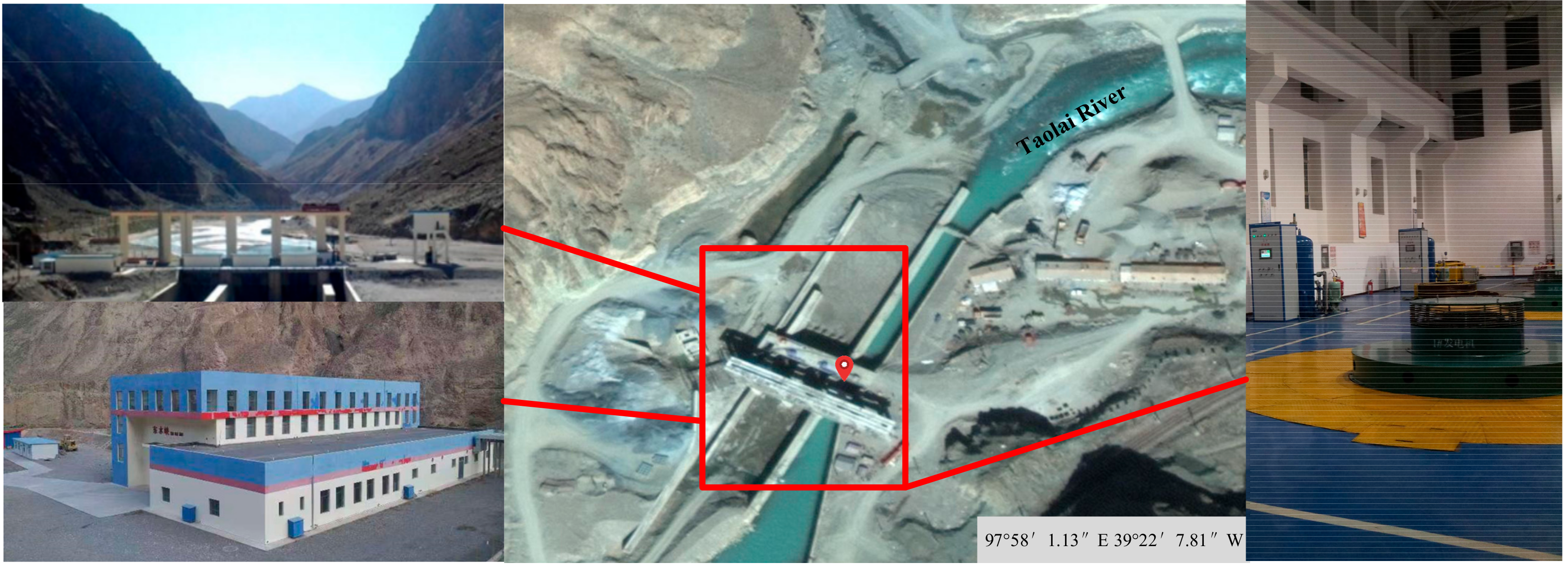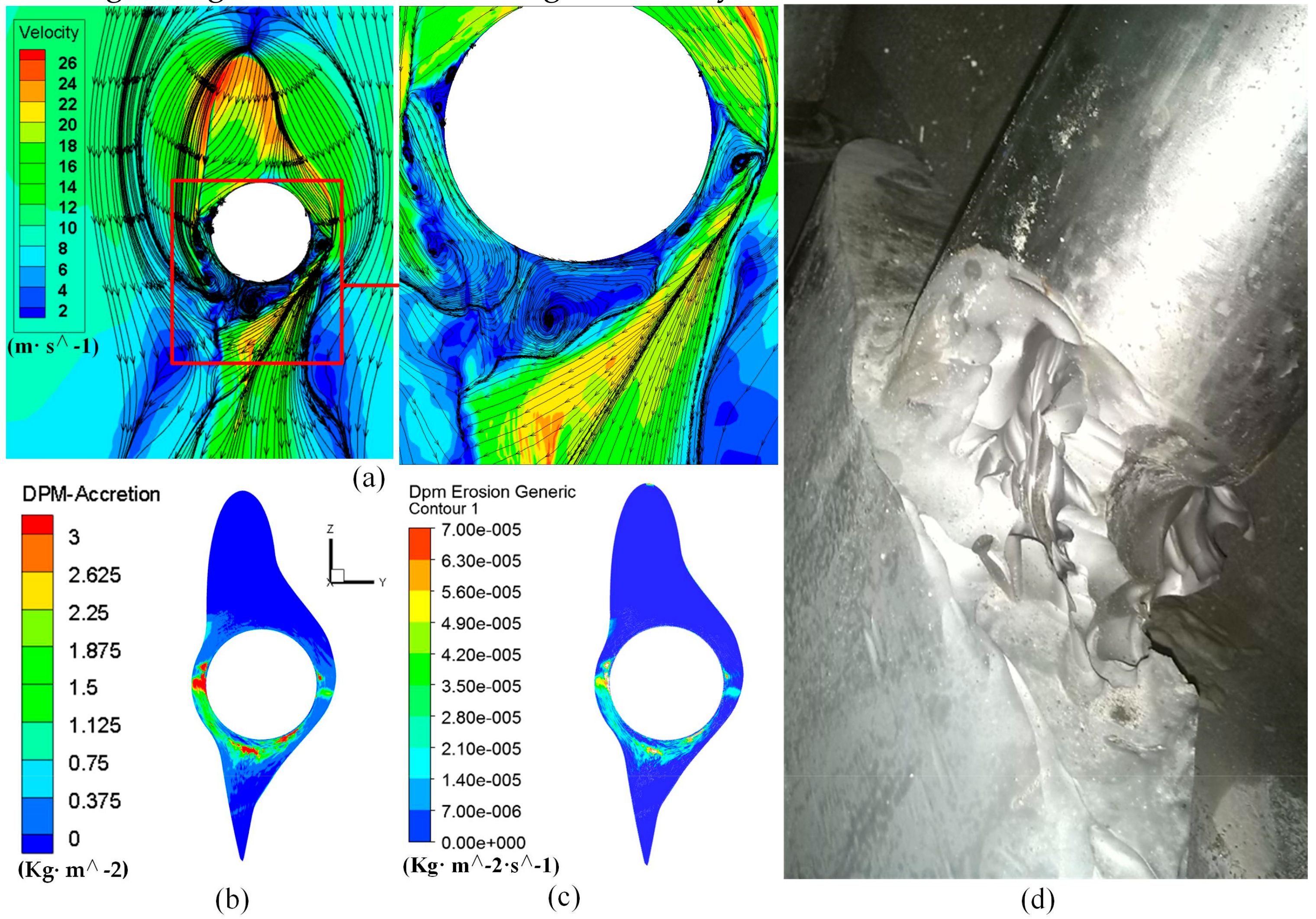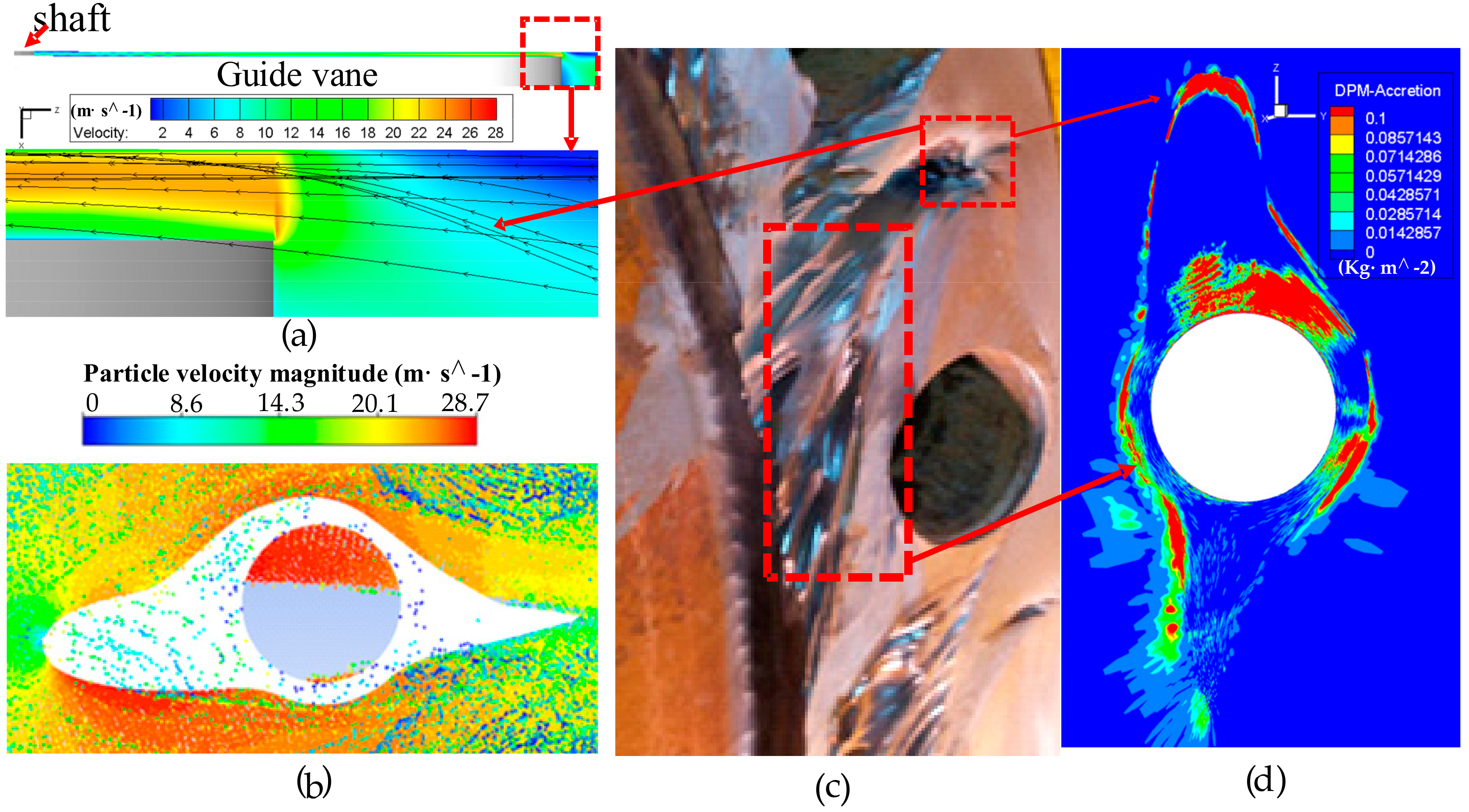1. Introduction
China is rich in water energy resources. The country’s outstanding features include precipitous watercourses with a concentrated distribution for climate, its topography and other factors, which are very beneficial to the development of hydropower [
1]. According to statistical data from the National Energy Administration, by the end of 2018, the total hydropower installed capacity and annual energy output in China were up to 350 GW and 1200 TWh, respectively. All natural water resources carry impurities such as suspended sediment and solid particulates. For hydro turbines working in the natural environment, flow problems can be classified as complex multiphase flow. In the China’s Yellow River and northwest inland basin, the running hydroelectric project suffers from maintenance challenges as sediment causes erosion of the flow passage components of the turbines (see
Figure 1). The energy loss caused by the outage or maintenance of the hydro turbine flow passage parts due to erosion is about 2–3 TWh each year, and the annual maintenance cost and renewal cost of equipment is hundreds of millions of yuan.
Guide vanes direct the sediment-laden water onto the runner blades at a suitable angle, thus providing a tangential velocity and an angular momentum to the sediment-laden water. Furthermore, a small end-clearance is designed at the upper and lower surface of the guide vane, allowing them to be pivoted to regulate the flow (see
Figure 2) [
2]. Turbines experience several unsteady sediment-laden flows where such flows contribute to erosion in the flow-passage walls of the guide vane clearance. The enlarged clearance would lead to changes in the flow pattern, increases in water leakage, losses in efficiency and output power, vibration, and even the final breakdown of the turbine components [
3,
4].
A number of detailed studies of the flow field around guide vanes and end-clearance flow have been undertaken by many scholars. A theoretical and experimental study of flow through the double cascade of a Francis turbine was conducted by Chen et al. [
5] who observed the flow around guide vanes with different sizes of end-clearance, where a crosswise leakage flow developed from the end-clearance due to the pressure gradient between the guide vane surfaces. An experimental apparatus with a cascade of guide vanes in a Francis turbine was developed by Thapa et al. [
6,
7,
8] who observed leakage flow as a jet flow, which was mixed with the mainstream in the transverse direction and then formed a vortex. Therefore, the inlet flowrate of runner blades will be uneven.
In the aspect of numerical simulations studies, Koirala et al. [
9] used the Tabakoff erosion model to analyze the erosion in Francis turbines and studied the effect of the guide vane clearance gap on Francis turbine performance. A very thorough numerical investigation detailed by Tallman et al. [
10] showed the influence of clearance size on the leakage flow, vortex, and secondary flow. Noon et al. [
11] used the k-omega based Shear-Stress-Transport (SST) model and the Finnie and Tabakoff erosion models in ANSYS CFX to studied flow field and erosion wear on Francis Turbine components due to sediment flow, who found that erosion and efficiency loss both decreases with increase in particle shape factor. Messa et al. [
12] used a volume of fluid (VOF) model for simulating the free nozzle jet, a Lagrangian particle tracking model for the trajectories of the solid particles, and Oka and det norske veritas (DNV) models for estimating the mass removal. A previously validated multiscale model of erosion is presented by Leguizamón et al. [
13,
14] to obtain erosion distribution and the erosion process of Pelton bucket impacted by a sediment-laden water jet. This model consists of two coupled sub-models. The sediment impacts are simulated by means of comprehensive physical models on the microscale and turbulent sediment transport and erosion accumulation are calculated on the macroscale. Brekke [
15] studied the mechanisms of sediment erosion at guide vanes, where erosion was categorized as turbulence erosion, secondary flow erosion, leakage erosion, and acceleration erosion. In addition, the influence of end-clearance on turbine efficiency was studied, where the loss in efficiency is greater than the increase of leakage flow. Koirala [
16] showed that high quartz content, inefficiency of the flushing system, higher concentration of sediment load, high impingement velocity, and operation at low guide vane angles were the major contributors to sediment erosion in guide vanes. The end-surface clearance flow of the turbine guide vane was simplified as circular-cylinder flow and backward-facing step flow by Han [
17,
18,
19]. The erosion of the flow-passage walls with inlet velocity, particle diameter, and particle density has been studied by the discrete phase model (DPM) and mixture model, and the sediment-wear morphology prediction method based on the differential-quadrature method has been proposed.
Through a comparison and analysis of the above references, few studies have been conducted on the turbulence characteristics and erosional mechanism at the end-clearance flow of guide vanes with a large eccentric shaft. This paper used the end-clearance flow of the turbine guide vanes with a large eccentric shaft at the Dongshuixia hydropower station as the research object, and simulated the flow in the clearance and around the guide vane with a large eddy simulation (LES) and discrete phase model (DPM). Using the actual wear pattern of the unit, the turbulence characteristics and the wear mechanism of the guide vane were analyzed and studied.
2. Sediment Erosion Status of Dongshuixia Hydropower Station
The Dongshuixia hydropower station is a water diversion and electric generating project with a low-clam long tunnel, and is located at the main stream canyon segment of the Taolai river in Sunan County of Gansu Province (see
Figure 3). The average annual generated energy is up to 2.43 billion kW·h. This project was completed and put into operation in July 2012, which was of great significance to improve the local network structure, palliate the power shortage, and promote the development of the local economy.
This hydropower station is a run-off hydroelectric station without storage capacity, which fails to discharge sand effectively in service, resulting in a high concentration of sediment. After operation through two flood seasons with a sediment-laden river, no obvious sediment erosion was found when the distributor was under a heavy load. Whereas in the dry season, the sediment erosion of the distributor was very serious. Through the numerical simulation of the three-dimensional flow field of the turbine, the velocity and pressure in the head cover was uniformly distributed, and there was no negative pressure zone and no flow separation. Therefore, under normal circumstances, the hydrodynamic cavitation does not take place in the guide vane, head cover region, and bottom ring. Therefore, sediment erosion is the main reason for the erosion of the distributor flow-passage walls. The sediment erosion regions mostly focus on the guide vane, head cover, bottom ring, upper and lower fixed wearing ring, guide vane sleeve, etc. There were abrasion pits of 5–15 mm on the upper and lower end surfaces behind the guide vane shaft, the erosion depth of the end clearance of guide vane was 10–20 mm, and sediment erosion of the guide vane sleeve was more severe.
Sediment samples from three different positions at the Dongshuixia hydropower station forebay were collected by a suspended sediment sampler. The weight of each sample was not less than 50 g, and the distance between the sampling points was about 12 km. After the clarifying, pouring out the clear water, and drying steps, a laser granularity analyzer was used to analyze the particle size in this study. The median particle size d50 of the sand particles entering the turbine was 45 μm, and its average density was 2650 kg/m3.
3. CFD Predictions
Computational fluid dynamics (CFD) was conducted using the commercially available ANSYS Fluent 19.0, which offers discrete phase models (DPM). This model considers the interactions between particles and fluids. The fluid phase was treated as a continuum by solving the Navier–Stokes equations, while the dispersed phase was solved by tracking a large number of particles through the calculated flow field. The steady simulation results of the SST k-ω turbulence model (number of iterations: 10,000) were used as the initial value of the LES calculation. These models were used to model the turbulent flow due to their superiority for complex turbulence in the clearance.
3.1. Liquid Phase Model
In order to study the relationship between turbulent characteristics and erosion wear in the end-clearance of turbine guide vane in detail, LES model with high precision on turbulence simulation is used to simulate the flow field. The instantaneous motion signals of turbulence were decomposed into two parts: The vortex motion of the large-scale structures and small-scale structures by LES through the filter function. In the process, large vortices were directly calculated, while small vortices were modeled. The filter function
G(x, x′) used in the paper can be written as follows:
where Δ is the mean scale of grid (m); x is the space coordinate on the large-scale space after filtering; and x′ is the space coordinate of the actual flow region.
The governing equations obtained after filtering are:
where
and
are the velocity vectors of the grid scale in the x
i and x
j direction (m/s);
is the static pressure of the grid scale (Pa);
ρ is the fluid density (kg/m
3); μ is the hydrodynamic viscosity (Pa·s);
is the stress tensor of sub-grid scale (Pa);
, which shows the influence of small-scale vortex motion on the momentum transportation of a large-scale vortex, and was obtained by the subgrid scale model. The standard Smagorinsky-Lilly model is generally adopted, but the introduced model parameter Cs will affect the turbulence parameter (turbulent dissipation rate). In this study, a dynamic Smagorinsky-Lilly model was adopted, which assumes that the subgrid stress is proportional to the strain rate of the local fluid, and the expression is as follows:
where
is the von Kármán constant and generally taken as 0.42. In the dynamic Smagorinsky–Lilly model,
Cs is not a constant, and needs to be calculated according to the local flow field information to simulate the flow field more accurately.
3.2. Solid Phase Model
The DPM used by ANSYS Fluent contains the assumption that the solid phase is sufficiently dilute so that the particle–particle interactions are negligible. In practice, these issues imply that the discrete phase must be present at a fairly low volume fraction, usually less than 10–12% [
20]. In this study, the volume fraction of the sediment particles was calculated as 0.04%, which meets the calculation requirements of DPM model.
The trajectory of a discrete phase particle is determined by integrating the force balance on the particle, which is written in a Lagrangian reference frame. This force balance equates the particle inertia with the forces acting on the particle, and can be written as
where
is the particle mass (kg);
is the fluid phase velocity (m/s);
is the particle velocity (m/s);
is the fluid density (kg/m
3);
is the particle density (kg/m
3);
is an additional force (N);
is the drag force; and
is the particle relaxation time calculated by:
where,
μ is the molecular viscosity of the fluid (Pa·s);
dp is the particle diameter (mm);
Cd is the drag coefficient; and R
e is the relative Reynolds number, which is defined as:
Equation (8) incorporates additional forces (
) in the particle force balance that can be important, which includes the virtual mass, pressure gradient, and Saffman’s lift force. The virtual mass and pressure gradient forces are important when the density ratio of the density of the fluid and the particles is greater than 0.1. The virtual mass force (
) required to accelerate the fluid surrounding the particle. The pressure gradient forces (
) arise due to the pressure gradient in the fluid. The Saffman’s lift force arises due to shear.
where
is the virtual mass factor with a default value of 0.5.
For non-spherical particles Haider and Levenspiel [
21] developed the correlation:
where:
The shape factor
is defined as:
where
s is the surface area of a sphere having the same volume as the particle, and
S is the actual surface area of the particle. The handbook by W.C. Yang [
22] indicates the sphericity of sharp and round sand particles to be 0.66 and 0.86, respectively. Therefore, the shape factor is given as 0.86 of round sand particles in this study.
The particle rebound characteristics (velocity and angle) must be calculated to obtain the trajectory of particles after it collides with the flow passage walls. The particle rebound velocity is less than the impingement velocity, which is described by the pertinent restitution ratios. The particle rebound model mainly includes the stochastic particle-wall rebound model by Grant and Tabakoff [
23] and the non-stochastic particle-wall rebound model by Forder et al. [
24]. In this study, the Tabakoff particle rebound model [
25] was adopted. The pertinent restitution ratios are defined as follows:
where
is the normal restitution ratio;
is the tangential restitution ratio; and
θ is the impingement angle of the particle between the impact trajectory of the particle and the tangential surface across the impact point (°).
3.3. Erosion Model
The choice of the erosion model and correlation coefficients have influence on the erosion wear results, and the research results of Messa G V and Malavasi S are support the above view [
26]. In this study, the erosion rate and erosion pattern on the surface of the flow passage components caused by the impacts of sand particles were calculated using the generic erosion model. The erosion rate is defined as:
where
is a function of the particle diameter;
is the impact angle of the particle path with the wall face;
is a function of impact angle;
is the relative particle velocity;
is a function of relative particle velocity;
Aface is the area of the cell face at the wall (m
2); and
is the mass flow rate of particles impinging on the wall (kg/s).
The Tulsa angle dependent model is used to determine the correlation coefficient, which are suitable for steel being eroded by sand [
27]. In this study, the guide vane material specified in the clearance wall is ZGO4Cr13Ni5Mo, which is stainless steel. There are similarities between stainless steel and steel in material properties. Therefore, the selection of the erosion model and correlation coefficients are reasonable, but some error on the erosion magnitude is expected:
where
Fs is a particle shape coefficient as 0.2 for fully rounded sand [
27];
B is the Brinell hardness as 309 N/mm
2 for ZGO4Cr13Ni5Mo of the wall material.
From formula 17 and 20, when other variables are constant, the erosion rate is the largest with the impact angle as 0.634 rad. When the impact angle is less than 0.634 rad, the erosion rate increases with the increase of the impact angle. When the impact angle is greater than 0.634 rad, the erosion rate decreases with the increase of the impact angle.
The accretion rate is defined as:
3.4. Computational Domain
The guide vane used in turbine (HLA351-LJ-180) is a prototype with a net head of 189 m and capacity of 18.4 MW. A small end-clearance was present to adjust the guide vane angle, depending on the load or flow variation. The structure diagram of the end-clearance between the guide vane and the head cover of the turbine is shown in
Figure 4.
The design size of the end-clearance guide vane was 0.22 mm. However, the head cover is raised upward under the high-pressure effect of water in practical operation, making the actual clearance size slightly larger than the designed size, so that it reaches 1 mm. Therefore, the clearance size of 1 mm was used to study the turbulence and sediment erosion characteristics in the end-clearance. To study the influence of a guide vane with a large eccentric shaft on clearance flow (including the flow around the cylindrical shaft) and flow around the airfoil, the geometric structure of the upper part of the guide vane airfoil profiles was used in consideration of the computing resources and computing time. The 3D computational model and relative parameters for the end-clearance of the turbine guide vane are shown in
Figure 5.
A Francis turbine with a relatively low guide vane height has good watertight condition. However, the end-clearance of a guide vane is rapidly enlarged because of the high-water pressure, large deformation of the head cover, and sediment erosion. Hence, it is of great necessity to solve the leakage of the end-clearance of the guide vane. The guide vane of a Francis turbine used a large eccentric shaft structure (see
Figure 6), that is, a large wing plate was added to the upper and lower pressure surface of the guide vane, and the guide vane shaft was enlarged as much as possible. On one hand, this structure increases the retaining water length in the circumferential direction of the guide vane; on the other hand, it increases the covered area of the guide vane end region at the upper and lower facing plate and the leakage resistance. Thus, the leakage of the guide vane end-surface is reduced and the efficiency of the turbine improves. At the same time, this structure can prevent the direct erosion of the guide vane shaft by a sediment-laden river.
The computational domain was discretized using a structured grid as shown in
Figure 7. Boundary layers were utilized to keep y+ within its accepted limits and accurately consider the wall effects. The first layer thickness of 0.001 mm in the clearance domain was determined to meet the accuracy of the large eddy simulation calculation of the clearance flow field. Then, the y+ values were controlled to be below 1 in the clearance domain. There were 51 grid layers in the clearance of 1 mm to accurately capture the turbulence characteristics. For the purpose of confirming that the grid pattern used was adequate, a grid convergence test was conducted on five different grid numbers. With the increase of grid numbers, the variable quantity of pressure drops between inlet1 and outlet1 is less than 2% as the test standard. Finally, the grid numbers in the computational domain was 7.143 million.
3.5. Numerical Setup
To achieve an improved convergence, the finite volume method and SIMPLEC algorithm were utilized to disperse and compute the flow controlling equations. The first order upwind discretization scheme was used for both the convection and divergence terms. In the unsteady calculation (LES), the total calculation time was set as 1 s. Among the time steps, the size was defined as 0.0001 s, and the number of time steps was 10,000. The above calculations include the gravity effect. To obtain a converged solution, the following under relaxation factors were used: 0.3 for pressure, 1 for density, 0.35 for momentum, and 0.9 for the discrete phase sources. The convergence criteria were set as 1 × 10−8. The DPM iteration interval was set as 20. When the particles pass through the turbulent vortex, there will be an accompanying motion, which will lead to the lateral diffusion effect of the particles. Therefore, the discrete random walk model (DRW) was used to consider the interaction between the particles and discrete vortices of fluid.
According to the actual conditions and numerical simulation of the whole flow field of a hydro turbine, the fluid through the stay vane enters the end-clearance of the guide vane at a certain angle (under different guide vane openings). Therefore, the “velocity-inlet” boundary condition was used for clearance inlet1 and inlet2, and the velocity of the solid phase was set as the same velocity as that of the fluid phase. The direction of axes X, Y, and Z are shown in
Figure 5, the coordinate origin is on the axis, the
X-axis is along the axis and the
Z-axis and the
Y-axis are parallel and perpendicular to the chord length of the guide vane airfoil, respectively. The Y-velocity was −0.69799 m/s, and the Z-velocity was −19.9878 m/s. The “pressure-outlet” boundary condition at the outlet was set with the pressure of 1,300,000 pa, and nonslip flow conditions were used for the walls. Except the clearance inlet and outlet, the “wall” boundary condition was used for other surfaces. The roughness constant was set at a value of 0.5. Trajectories of the sediment particles were tracked by the Lagrangian method. At the inlet and outlet of the clearance flow, the boundary conditions for the solid phase were set as “escape” and the rest of the walls were set as “reflect”. The guide vane material specified in the clearance wall is ZGO
4Cr
13Ni
5Mo with a density of 7790 kg/m
3. The density and viscosity of the clear water phase was assumed to be 998.2 kg/m
3 and 0.001003 kg/(m·s), respectively. Furthermore, the sediment particles were assumed to be uniform and round shaped. The Taolai River is neutral water and its mean annual sediment content, average sediment concentration, and maximum sediment concentration was 1.12 kg/m
3, 2.5 kg/m
3, and 126 kg/m
3, respectively. The mean annual sediment content was used as the setting standard for sediment particle concentration. The d
50 of the sediment particles was 45 μm and the average density was 2650 kg/m
3.
3.6. Independence Test of the Particle Trajectory Number
Figure 8 shows the arrangement of the monitoring points. A2–A7 were set at the clearance flow (X = 0.5 mm), and A3–A6 were symmetric along the shaft center. A3′ and A4′ were set at the clearance wall (X = 0 mm). A1 and B1 were set at the inflow, A1 was set at the front of clearance flow, and B1 was set at the front of the guide vane. C1–C5 were isometrically set at the X direction of the guide vane wake.
The interaction between the liquid and solid particle was considered in this paper. The number of particle trajectory per unit inlet area determines the distribution of particles in the horizontal and vertical direction along the inflow, which is very important in the study of the erosion characteristics of the end-clearance surfaces. The total number of injected particles is determined by the total flow rate, which is the product of the inlet section area and average annual sediment concentration. When the total mass flow rate of particles is constant, the number of particle trajectory can be set by setting the sample density in the horizontal and vertical directions. The ratio of the total number of particle trajectory to the area of incident plane is the number of particle trajectory per unit inlet area. A3′ and A4′ are located at the large and small wing surface of the guide vane with erosion wear, which have certain representativeness. Therefore, A3′ and A4′ were selected for the independence test of the particle trajectory number. Numerical simulation of the end-clearance flow of guide vane was conducted with different numbers of particle trajectory per unit inlet area, and the changing rule of the average erosion rate at the monitoring points (A3′ and A4′) was obtained, as shown in
Figure 9. The number of particle trajectory per unit inlet area is the abscissa, and the average erosion rate with different ranges are the left and right side vertical coordinate.
With the increase in the number of particle trajectory per unit inlet area (mm2), the average erosion rate increases. When the number of particle trajectory per unit inlet area is greater than 1, the average erosion rate is basically stable. Therefore, in order to ensure converged results for a flow field with a 1 mm clearance, the number of trajectories per unit inlet area should be about 1/mm2.




















